
Concept explainers
How many
a.  c.
c.  e.
e.  g.
g. 
b.  d.
d.  f.
f.  h.
h. 
(a)
Interpretation: The number of
Concept introduction: The number of NMR signal in a compound is equal to the number of chemically non-equivalent protons present in that compound. Protons which are present in the same chemical environment that is between the same group of atoms are known as chemically equivalent protons and in
Answer to Problem 14.3P
The given compound, propane shows two signals in
Explanation of Solution
The number of signals in each compound is equal to the number of hydrogen atoms present in a different chemical environment. The given compound is propane that consists of two non-equivalent hydrogen groups. Therefore, the number of
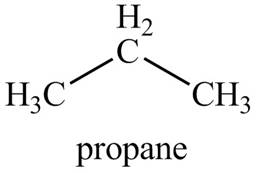
Figure 1
The given compound, propane shows two signals in
(b)
Interpretation: The number of
Concept introduction: The number of NMR signal in a compound is equal to the number of chemically non-equivalent protons present in that compound. Protons which are present in the same chemical environment that is between the same group of atoms are known as chemically equivalent protons and in
Answer to Problem 14.3P
The given compound, ethoxyethane shows two signals in
Explanation of Solution
The given compound is ethoxyethane that consists of two non-equivalent hydrogen groups. Therefore, the number of
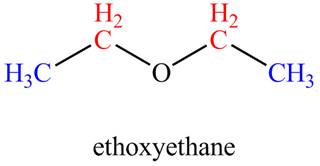
Figure 2
The given compound, ethoxyethane shows two signals in
(c)
Interpretation: The number of
Concept introduction: The number of NMR signal in a compound is equal to the number of chemically non-equivalent protons present in that compound. Protons which are present in the same chemical environment that is between the same group of atoms are known as chemically equivalent protons and in
Answer to Problem 14.3P
The given compound, butane shows two signals in
Explanation of Solution
The given compound is butane that consists of two non-equivalent hydrogen groups. Therefore, the number of
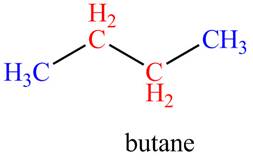
Figure 3
The given compound, butane shows two signals in
(d)
Interpretation: The number of
Concept introduction: The number of NMR signal in a compound is equal to the number of chemically non-equivalent protons present in that compound. Protons which are present in the same chemical environment that is between the same group of atoms are known as chemically equivalent protons and in
Answer to Problem 14.3P
The given compound,
Explanation of Solution
The given compound is

Figure 4
The given compound,
(e)
Interpretation: The number of
Concept introduction: The number of NMR signal in a compound is equal to the number of chemically non-equivalent protons present in that compound. Protons which are present in the same chemical environment that is between the same group of atoms are known as chemically equivalent protons and in
Answer to Problem 14.3P
The given compound, ethyl propanoate shows four signals in
Explanation of Solution
The given compound is ethyl propanoate that consists of four non-equivalent hydrogen groups. Therefore, the number of
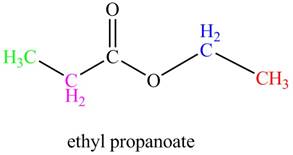
Figure 5
The given compound, ethyl propanoate shows four signals in
(f)
Interpretation: The number of
Concept introduction: The number of NMR signal in a compound is equal to the number of chemically non-equivalent protons present in that compound. Protons which are present in the same chemical environment that is between the same group of atoms are known as chemically equivalent protons and in
Answer to Problem 14.3P
The given compound,
Explanation of Solution
The given compound is

Figure 6
The given compound,
(g)
Interpretation: The number of
Concept introduction: The number of NMR signal in a compound is equal to the number of chemically non-equivalent protons present in that compound. Protons which are present in the same chemical environment that is between the same group of atoms are known as chemically equivalent protons and in
Answer to Problem 14.3P
The given compound,
Explanation of Solution
The given compound is
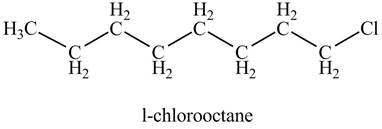
Figure 7
The given compound,
(h)
Interpretation: The number of
Concept introduction: The number of NMR signal in a compound is equal to the number of chemically non-equivalent protons present in that compound. Protons which are present in the same chemical environment that is between the same group of atoms are known as chemically equivalent protons and in
Answer to Problem 14.3P
The given compound,
Explanation of Solution
The given compound is

Figure 8
The given compound,
Want to see more full solutions like this?
Chapter 14 Solutions
Package: Loose Leaf for Organic Chemistry with Biological Topics with Connect Access Card
Additional Science Textbook Solutions
General, Organic, and Biological Chemistry - 4th edition
HUMAN ANATOMY
Campbell Biology: Concepts & Connections (9th Edition)
Organic Chemistry
Laboratory Manual For Human Anatomy & Physiology
- 1. Show the steps necessary to make 2-methyl-4-nonene using a Wittig reaction. Start with triphenylphosphine and an alkyl halide. After that you may use any other organic or inorganic reagents. 2. Write in the product of this reaction: CH3 CH₂ (C6H5)₂CuLi H₂O+arrow_forward3. Name this compound properly, including stereochemistry. H₂C H3C CH3 OH 4. Show the step(s) necessary to transform the compound on the left into the acid on the right. Bri CH2 5. Write in the product of this LiAlH4 Br H₂C OHarrow_forwardWhat are the major products of the following reaction? Please provide a detailed explanation and a drawing to show how the reaction proceeds.arrow_forward
- What are the major products of the following enolate alkylation reaction? Please include a detailed explanation as well as a drawing as to how the reaction proceeds.arrow_forwardA block of zinc has an initial temperature of 94.2 degrees celcius and is immererd in 105 g of water at 21.90 degrees celcius. At thermal equilibrium, the final temperature is 25.20 degrees celcius. What is the mass of the zinc block? Cs(Zn) = 0.390 J/gxdegrees celcius Cs(H2O) = 4.18 J/gx degrees celcusarrow_forwardPotential Energy (kJ) 1. Consider these three reactions as the elementary steps in the mechanism for a chemical reaction. AH = -950 kJ AH = 575 kJ (i) Cl₂ (g) + Pt (s) 2C1 (g) + Pt (s) Ea = 1550 kJ (ii) Cl (g)+ CO (g) + Pt (s) → CICO (g) + Pt (s) (iii) Cl (g) + CICO (g) → Cl₂CO (g) Ea = 2240 kJ Ea = 2350 kJ AH = -825 kJ 2600 2400 2200 2000 1800 1600 1400 1200 1000 a. Draw the potential energy diagram for the reaction. Label the data points for clarity. The potential energy of the reactants is 600 kJ 800 600 400 200 0 -200- -400 -600- -800- Reaction Progressarrow_forward
- Can u help me figure out the reaction mechanisms for these, idk where to even startarrow_forwardHi, I need your help with the drawing, please. I have attached the question along with my lab instructions. Please use the reaction from the lab only, as we are not allowed to use outside sources. Thank you!arrow_forwardHi, I need your help i dont know which one to draw please. I’ve attached the question along with my lab instructions. Please use the reaction from the lab only, as we are not allowed to use outside sources. Thank you!arrow_forward
- 5. Write the formation reaction of the following complex compounds from the following reactants: 6. AgNO₃ + K₂CrO₂ + NH₄OH → 7. HgNO₃ + excess KI → 8. Al(NO₃)₃ + excess NaOH →arrow_forwardIndicate whether the product formed in the reaction exhibits tautomerism. If so, draw the structure of the tautomers. CO₂C2H5 + CH3-NH-NH,arrow_forwardDraw the major product of this reaction N-(cyclohex-1-en-1-yl)-1-(pyrrolidino) reacts with CH2=CHCHO, heat, H3O+arrow_forward
 EBK A SMALL SCALE APPROACH TO ORGANIC LChemistryISBN:9781305446021Author:LampmanPublisher:CENGAGE LEARNING - CONSIGNMENT
EBK A SMALL SCALE APPROACH TO ORGANIC LChemistryISBN:9781305446021Author:LampmanPublisher:CENGAGE LEARNING - CONSIGNMENT Organic Chemistry: A Guided InquiryChemistryISBN:9780618974122Author:Andrei StraumanisPublisher:Cengage Learning
Organic Chemistry: A Guided InquiryChemistryISBN:9780618974122Author:Andrei StraumanisPublisher:Cengage Learning


